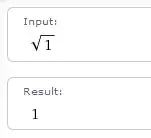Why does Wolfram Alpha say that $\sqrt{1}=-1$?

Is this a mistake or what? Can anyone help?
Thanks in advance.
Why does Wolfram Alpha say that $\sqrt{1}=-1$?

Is this a mistake or what? Can anyone help?
Thanks in advance.
Did you read the results carefully? It does give $1$ as the answer:

It then helpfully mentions that $-1$ is also a 2nd root of $1$:

which is perfectly correct, because $(-1)^2=1$.
There are two real values which are roots of $1$: $$(-1)^2 = (1)^2 = 1$$
Exactly one of those values, the non-negative root, is called the principal square root of $1$, and is the real value returned by the the square root function $f$: $$f: \mathbb R^{\geq 0} \to \mathbb R^{\geq 0},\quad f(x) = \sqrt x,\quad\text{where}\;f(1) = \sqrt 1 = 1$$
but $(-1)$ is also, by definition, a real (non-principal) root of $1$.
See also principal square root in Wikipedia.
$-1$ is a perfectly valid square root of 1... think about it: $(-1)^2=1$, after all!
It is not what we usually call the "principle branch" of the square root, where you would expect to get 1.
By writing $\sqrt{x}$ with $x>0$ , you implicitly mean the principal square root which is always positive. This is called the square root of $x$.
There is always another (negative) number whose square is $x$, namely $-\sqrt{x}$, in your case $-1$. The wolfram alpha has made it clear by saying:
1 (real, principle root)
-1 (real root)